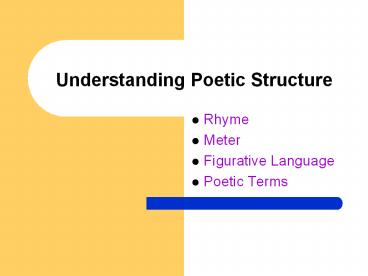Understanding%20Poetic%20Structure - PowerPoint PPT Presentation
Title:
Understanding%20Poetic%20Structure
Description:
Understanding Poetic Structure Rhyme Meter Figurative Language Poetic Terms Rhyme The repetition of vowel sounds in accented syllables and all syllables that follow ... – PowerPoint PPT presentation
Number of Views:232
Avg rating:3.0/5.0
Title: Understanding%20Poetic%20Structure
1
Understanding Poetic Structure
- Rhyme
- Meter
- Figurative Language
- Poetic Terms
2
Rhyme
- The repetition of vowel sounds in accented
syllables and all syllables that follow (ex.
glisten listen) - When rhyme is found within the same line of
poetry, it is internal rhyme - When rhyme is found at the end of lines of
poetry, it is end rhyme
3
Rhyme
- The purpose of rhyme is to create a sound
cadence for the reader - Poets often create a pattern of end rhyme
- This pattern, when identified, is called a rhyme
scheme - When determining the rhyme scheme, each rhyming
sound is represented by a different letter of the
alphabet
4
Rhyme
- Because rhyming is difficult, and to create
different effects on the reader, poets also use
approximate rhyme - Approximate rhyme is also known as off rhyme,
half rhyme, or slant rhyme - These rhymes can be equated to a sharp or flat
note in music
5
Meter
- A pattern of stressed and unstressed syllables
in a line of poetry - Each syllable in a line of poetry is labeled
with a stress mark, or an unstressed mark - The purpose of meter is to create a recognizable
rhythm through a regular sound pattern of
stressed and unstressed syllables
6
Meter
- Metrical patterns, composed of stressed and
unstressed syllabic marks, create a foot of meter - Common metrical feet are iambic, anapestic,
trochaic, and dactylic - Each is a different combination of stressed and
unstressed syllabic marks
7
Meter
- An iambic foot of meter is composed of an
unstressed syllable followed by a stressed
syllable - An anapestic foot of meter is composed of two
unstressed syllables followed by a stressed
syllable
8
Meter
- A trochaic foot of meter is composed of a
stressed syllable followed by an unstressed
syllable - A dactylic foot of meter is composed of a
stressed syllable followed by two unstressed
syllables - Reading a poem to determine its metrical pattern
is called scansion
9
Meter
- A poem that has two of a particular metrical
foot in each line is written in dimeter - If it has three metrical feet in each line it is
written in trimeter - If it has four feet, it is written in tetrameter
- If it has five feet, it is written in pentameter
- Six feet hexameter Seven feet heptameter
- Eight feet - octameter
10
Figurative Language
- Using words or phrases to describe something in
terms of another thing, with the intent that the
description will not be taken literally - The more common figures of speech are simile,
metaphor, personification, and symbol - Conceit is an elaborate figure of speech that is
often lengthy, and which compares two startlingly
different objects
11
Figurative Language
- Sound devices are also a form of figurative
language - Some common sound devices are assonance,
alliteration, consonance, onomatopoeia - Other figures of speech are hyperbole, metonymy,
oxymoron, synecdoche
12
Poetic Devices and Terms
- Allusion is a reference to someone of something
known from history, literature, religion, sports,
science, etc. allusion is a device also used in
other forms of writing - Apostrophe is a technique a poet uses to address
an inanimate object, idea, or person who is dead
or absent apostrophe is also used in other
forms of writing
13
Poetic Devices and Terms
- Caesura is a pause or break within a line of
poetry - Concrete Poem is a poem in which the words of
the poem themselves are arranged in a manner to
visually suggest the poems subject of meaning - Couplet consists of two rhyming lines of poetry
14
Poetic Devices and Terms
- Dramatic monologue is a poem in which a
character in the poem speaks to one or more
listeners - Epic is a long narrative poem it uses very
formal language and recounts heroic figures - Free verse is poetry that does not conform to a
regular meter or rhyme scheme
15
Poetic Devices and Terms
- Lyric Poem is a poem that does not tell a story,
but expresses the personal thoughts or feelings
of the speaker/poet - Octave is an eight line poem, or more often, the
first eight lines of a Petrarchan sonnet - Ode is a lyric poem that is usually very long
- Quatrain is a poem consisting of four lines that
function as a unit of thought
16
Poetic Devices and Terms
- Refrain is a word, phrase, line, or group of
lines in a poem that are repeated for effect
several times during a poem - Sestet is a six line poem, especially the last
six lines of a Petrarchan sonnet - Sonnet is a fourteen line poem, usually written
in iambic pentameter, and following a Petrarchan
or Shakespearian structure































